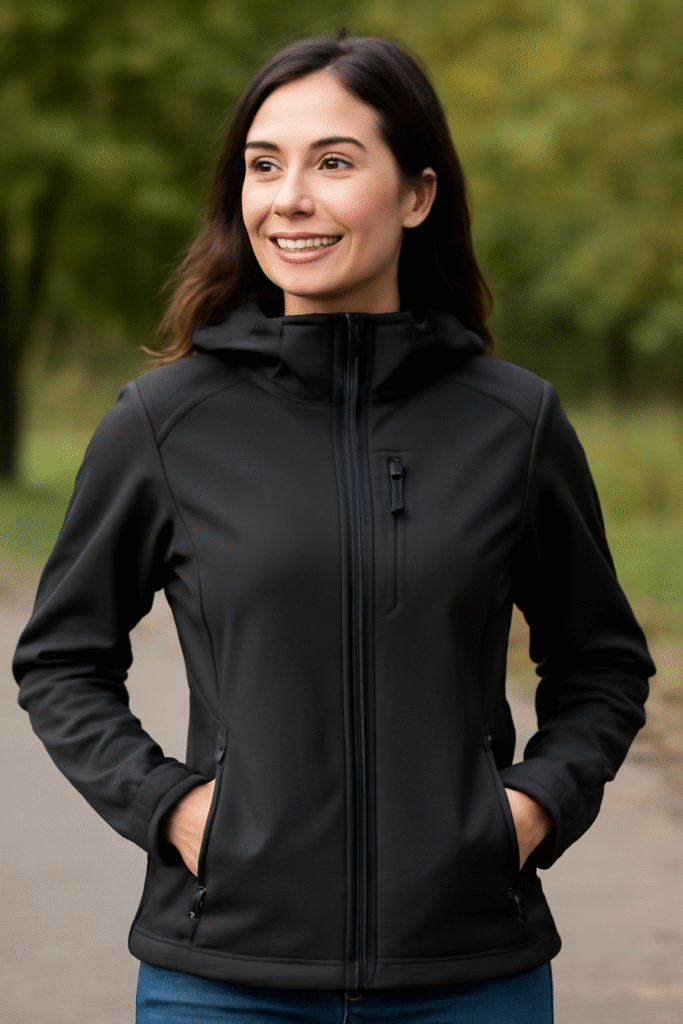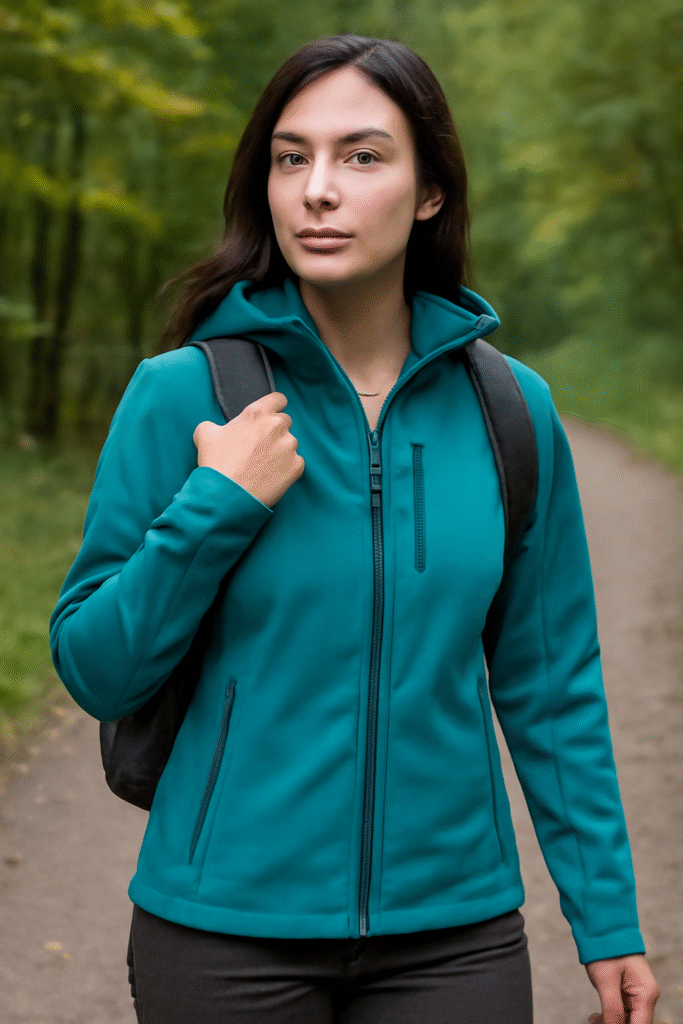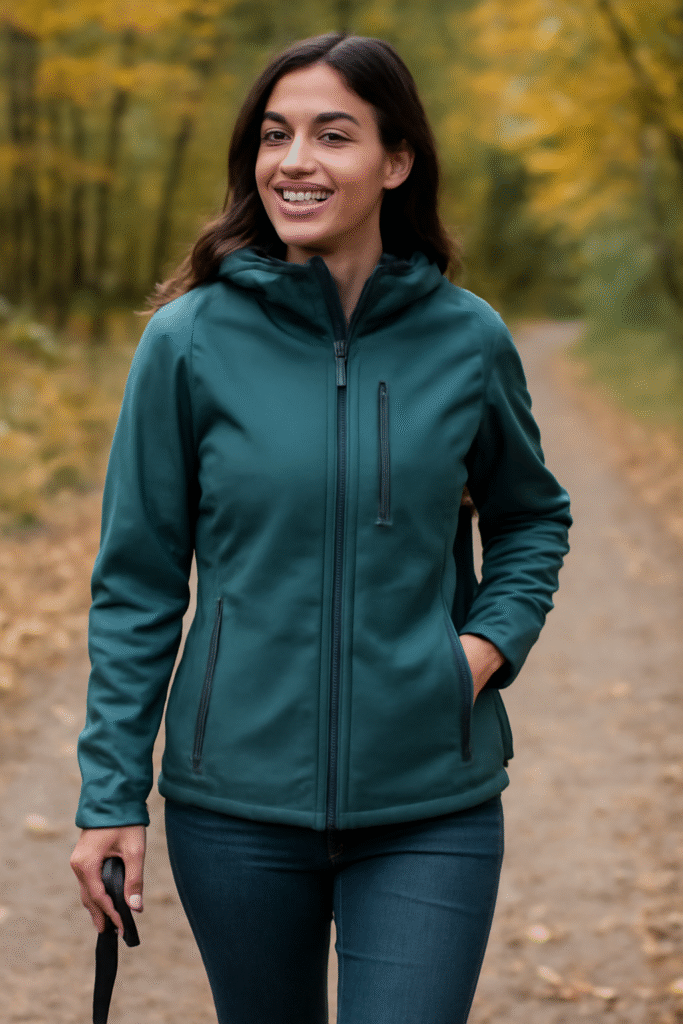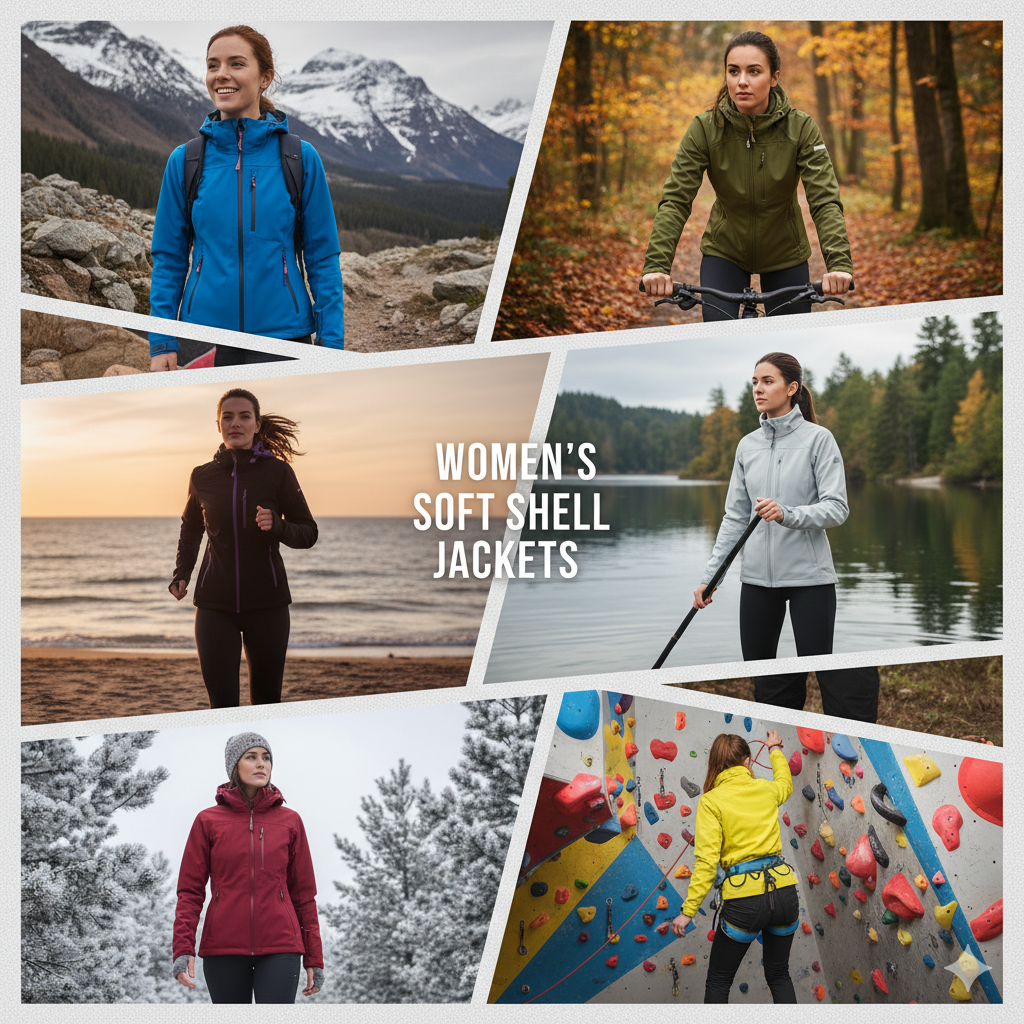When looking for a jacket that offers both warmth and flexibility, womens soft shell jackets are the perfect choice. Soft shell jackets are made from materials that stretch, offer a great fit, and provide protection from wind and water. They are not as heavy as traditional winter jackets but still offer great performance in cold weather. Whether you are heading out for a walk, a hike, or just want to stay warm in everyday activities, a soft shell jacket can meet all your needs.
What Makes a Soft Shell Jacket Special?
A women’s soft shell jacket is designed to balance comfort, style, and functionality. Unlike hard shell jackets, which are typically bulky and designed for extreme weather, soft shells are lightweight and flexible. The outer fabric is usually made from a woven nylon or polyester blend, while the inside is often lined with fleece or a similar soft material. This design makes them breathable and comfortable for a variety of outdoor activities.
These jackets are perfect for moderate weather. They keep you warm without overheating, and they are also water-resistant, which makes them ideal for rainy days. Soft shell jackets are often preferred over other types of jackets for active outdoor use due to their mobility and comfort.
Benefits of Women’s Soft Shell Jackets
- Comfortable Fit
Soft shell jackets are known for their comfort. The stretchy materials allow for easy movement, making them great for activities like hiking, running, or biking. Unlike other jackets that can feel stiff, soft shell jackets stretch and move with you, ensuring that you can stay active without feeling restricted. - Breathability
A great feature of a women’s soft shell jacket is its breathability. The fabric allows air to flow through, which helps prevent overheating. This is especially important when you are active outdoors. Breathable fabrics keep you dry by wicking away sweat, helping you stay comfortable even during intense activity. - Weather Resistance
While they are not fully waterproof, soft shell jackets do offer some level of water resistance. The materials used are designed to keep light rain or snow at bay. Some jackets even come with water-repellent finishes that can help to shed moisture. This makes them perfect for those who need protection from unpredictable weather but don’t want to carry around a bulky jacket. - Lightweight Design
Soft shell jackets are generally lighter than traditional winter coats, making them easy to pack and wear. This makes them a great option for traveling, outdoor events, or casual walks. Their lightweight nature means they can be worn as a mid-layer under heavier jackets when the temperature drops, or as an outer layer when the weather is mild. - Stylish Appearance
While functionality is important, the design of a women’s soft shell jacket is equally crucial. These jackets come in many colors and styles, from sporty to casual, making them a great addition to any wardrobe. They are perfect for women who want something functional but also stylish. You can wear them on the trails or in the city, and they will always look good.
How to Choose the Best Womens Soft Shell Jacket ?

When shopping for a women’s soft shell jacket, it is important to consider factors such as fit, fabric, and intended use. Here are some tips to help you choose the best jacket for your needs.
- Fit and Comfort
Choose a jacket that fits well. A good fit ensures that the jacket won’t restrict your movement and allows for layering underneath. If you plan to wear your soft shell jacket while hiking or doing other active activities, look for a style that has an athletic or slim fit. This will help prevent excess bulk and allow for a full range of motion. - Fabric and Insulation
Look for a soft shell jacket made from a fabric that is both breathable and water-resistant. Many jackets use a blend of polyester and spandex to provide a stretchy, durable outer shell. Some jackets also come with added insulation for extra warmth, so consider your climate and activity level when choosing the right option. - Weather Protection
Soft shell jackets are designed to handle mild to moderate weather, but they are not fully waterproof. If you plan to use your jacket in areas with heavy rain, consider choosing one that has additional waterproof features like a water-resistant zipper or a built-in hood to protect your head and neck from the elements. - Pockets and Storage
Consider the number of pockets on the jacket. Pockets can be useful for storing small essentials like keys, a phone, or a wallet. Many women’s soft shell jackets come with zippered pockets to keep your items safe while on the move. - Style
Soft shell jackets are available in many different designs. Whether you prefer a minimalist look or something with extra features like vents or reflective elements for visibility, there is a style to suit every need. Choose a jacket that matches your personal style and can easily be paired with your existing wardrobe.
Frequently Asked Questions (FAQ)
1. Are soft shell jackets warm enough for winter?
Soft shell jackets provide moderate warmth, but they are not designed for extreme winter conditions. They are ideal for mild to cool temperatures, especially when you are active outdoors. If you need more warmth in colder temperatures, you can layer a soft shell jacket over a thermal shirt or sweater.
2. Can I wear a soft shell jacket in the rain?
Yes, soft shell jackets are water-resistant and can handle light rain or snow. However, they are not fully waterproof. If you are expecting heavy rain, it may be better to look for a waterproof jacket or layer your soft shell jacket with a rain jacket for added protection.
3. What activities are soft shell jackets good for?
Women’s soft shell jackets are great for outdoor activities such as hiking, running, cycling, and skiing. They are designed for active movement and provide a good balance of warmth and breathability, making them perfect for sports and outdoor adventures.
4. Are soft shell jackets breathable?
Yes, one of the main advantages of a soft shell jacket is its breathability. The fabric allows air to pass through, which helps prevent you from overheating during physical activity. This makes soft shell jackets great for outdoor exercise and long hikes.
5. How should I care for my soft shell jacket?
To keep your women’s soft shell jacket in good condition, follow the care instructions on the label. Most soft shell jackets can be machine washed, but it is important to avoid using fabric softeners, as they can reduce the jacket’s water-resistance. Be sure to air dry the jacket or use a low-heat setting on the dryer.
Versatility of Women’s Soft Shell Jackets: A Year-Round Wardrobe Essential
A women’s soft shell jacket is more than just a cold-weather garment. Thanks to its flexibility and weather-resistant properties, it is perfect for all seasons. Whether you’re braving chilly mornings, light rain, or cool evenings, these jackets offer comfort and protection no matter the time of year. In this section, we’ll dive deeper into how a soft shell jacket can be used throughout the year, from the fall to spring.
Soft Shell Jackets in Fall and Spring

During the fall and spring months, the weather can be unpredictable. You may experience everything from sunny warmth to sudden rain showers. A women’s soft shell jacket is perfect for these transitional seasons due to its ability to keep you comfortable through fluctuating temperatures.
- In Fall: As temperatures begin to drop, a soft shell jacket provides just enough warmth to keep you comfortable without being too hot. The windproof qualities of the jacket are especially helpful in the fall when winds start to pick up. The breathability ensures that you won’t overheat while taking a brisk walk or running errands. You can also easily layer the jacket over a lightweight sweater or T-shirt to adjust to the changing weather throughout the day.
- In Spring: Spring weather is often marked by inconsistent temperatures and occasional rain. A soft shell jacket is a great option to protect yourself from light showers while keeping you warm enough during the cooler mornings and evenings. The water-resistant fabric will keep you dry when the rain starts to fall, while the light weight of the jacket prevents overheating as the sun comes out. Its breathability ensures that you stay cool even when the temperatures rise throughout the day.
Soft Shell Jackets for Outdoor Adventures

For women who enjoy outdoor activities, a soft shell jacket is an essential item in their wardrobe. From hiking to skiing, these jackets are designed to handle the elements while offering comfort and flexibility. Let’s explore how these jackets perform during various outdoor activities.
- Hiking and Trekking: A women’s soft shell jacket is a top choice for hiking, as it allows for a full range of motion. The stretchy fabric ensures you can move freely, whether you are navigating rocky terrain or climbing steep inclines. The breathability of the jacket helps regulate your body temperature, preventing you from getting too hot or cold during your hike. If you encounter light rain, the jacket’s water-resistant properties will keep you dry.
- Cycling and Running: Whether you’re cycling through the countryside or running on a trail, a soft shell jacket provides the right balance of warmth and breathability. The lightweight design allows you to move quickly and comfortably without feeling weighed down. Additionally, many soft shell jackets come with reflective elements, improving visibility during early morning or evening runs and rides.
- Skiing and Snowboarding: When hitting the slopes, a soft shell jacket can provide the necessary protection from the wind and cold. Many soft shell jackets are designed specifically for winter sports, with additional features like adjustable hoods and ventilation zippers. These jackets are perfect for active winter days when you need a jacket that moves with you but still offers protection from the elements.
How to Layer with a Women’s Soft Shell Jacket
A women’s soft shell jacket is not just an outer layer but also a great base layer when paired with other clothing. Layering is an effective way to adapt to fluctuating weather conditions, and a soft shell jacket can play an essential role in creating an effective layering system.
- Underneath Layer: If the weather is particularly cold, layer a soft shell jacket over a thermal shirt or long-sleeve top. This will keep your body warm without adding unnecessary bulk. The breathable fabric of the jacket will prevent you from getting too hot while still offering protection from the cold.
- Middle Layer: In colder conditions, you can layer a fleece jacket or down vest under the soft shell jacket. This combination provides both warmth and flexibility, ensuring that you stay warm without feeling restricted. The fleece layer will trap body heat, while the soft shell jacket will act as a windbreaker and water-resistant outer layer.
- Outer Layer: When it’s colder or when the rain is heavier, consider wearing a waterproof shell jacket over your soft shell jacket. This layering technique keeps you fully protected from the elements while still offering the flexibility and breathability of a soft shell.
What Makes Soft Shell Jackets Different from Hard Shell Jackets?
While both soft shell jackets and hard shell jackets serve the purpose of providing protection against the elements, there are key differences between the two. Understanding these differences can help you make an informed decision on which jacket is best for your needs.
- Flexibility: Soft shell jackets are made from flexible, stretchy fabrics that provide more freedom of movement compared to the stiffer construction of hard shell jackets. If you’re someone who enjoys outdoor activities like hiking or cycling, a soft shell jacket is the ideal choice for staying active and comfortable.
- Water Resistance vs. Waterproof: While soft shell jackets are water-resistant, they are not completely waterproof. On the other hand, hard shell jackets are fully waterproof and are designed for heavier rain or snow. If you know you’ll be dealing with wet conditions, a hard shell jacket might be more appropriate. However, if you are engaging in light activities and expect moderate rain, a soft shell jacket should suffice.
- Weight and Packability: Soft shell jackets are lighter and more packable than hard shell jackets. This makes them easier to carry on outdoor trips or throw into your bag when traveling. Hard shell jackets, while more protective, tend to be bulkier and heavier.
- Insulation: Hard shell jackets are often paired with additional layers for insulation, whereas soft shell jackets come with built-in insulation or can be worn over base layers for warmth. For active use, a soft shell jacket offers the perfect balance of warmth, flexibility, and protection from the elements.
Frequently Asked Questions (FAQ) – Continued
6. Can I wear a soft shell jacket in the winter?
While women’s soft shell jackets are great for cool temperatures, they are not as suitable for extreme winter conditions, especially if you’re exposed to heavy snow and sub-zero temperatures. However, they are perfect for moderate winter weather when paired with appropriate layers.
7. How do I clean my soft shell jacket?
Most soft shell jackets are machine washable. However, it is crucial to follow the care instructions on the label to ensure the jacket maintains its water-resistant properties. Avoid using fabric softeners, as they can damage the material. Air drying is often recommended to preserve the jacket’s shape and performance.
8. Are soft shell jackets good for travel?
Yes, soft shell jackets are an excellent choice for travel. They are lightweight, packable, and versatile, making them perfect for varying climates. Whether you’re traveling by plane, car, or train, a soft shell jacket can be easily packed into a bag and worn during various outdoor activities.
9. Can I use a soft shell jacket for casual wear?
Absolutely! Women’s soft shell jackets are stylish enough for casual wear. Whether you’re running errands or meeting friends, these jackets come in various colors and styles to match your everyday outfits. Their casual look makes them a great addition to your wardrobe.
10. Do soft shell jackets come in different sizes?
Yes, soft shell jackets are available in a variety of sizes, from small to plus sizes. When shopping for a soft shell jacket, make sure to check the brand’s sizing chart to find the right fit for your body type.
Soft Shell Jackets for Every Occasion: Comfort and Performance All Year Long

A women’s soft shell jacket is a must-have wardrobe staple due to its flexibility, comfort, and performance in various weather conditions. This versatile garment is not just for outdoor enthusiasts—it’s ideal for anyone looking for an easy-to-wear jacket that offers both style and practicality. In this section, we will explore how soft shell jackets can be used in different situations and how they stand out in comparison to other outerwear options.
Everyday Use: A Jacket for Any Occasion
One of the main advantages of a shell jacket is its adaptability. While it’s often associated with outdoor sports and activities, it can also be worn as an everyday jacket for various occasions. Whether you’re commuting to work, meeting friends for a casual outing, or running errands, a soft shell jacket offers comfort and protection without compromising on style.
- Commuting and Daily Activities: During the cooler months, a women’s soft shell jacket can be the perfect choice for daily activities. Whether you are walking to work or simply enjoying a stroll in the park, this jacket keeps you warm without being bulky. Many soft shell jackets have a fitted design, making them look more polished and refined compared to other bulky jackets. You can easily pair it with jeans, leggings, or casual skirts to create a stylish and functional outfit.
- Outdoor Events and Festivals: Soft shell jackets are an excellent option for attending outdoor events such as concerts, festivals, or picnics. The lightweight design ensures you won’t overheat, and if the weather takes a turn, the water-resistant material will protect you from light rain or wind. With various color options available, you can find one that fits your personal style while staying comfortable throughout the day.
- Traveling: Traveling can involve a variety of weather conditions, and a soft shell jacket is the perfect travel companion. It’s easy to pack, lightweight, and provides protection against rain and wind, making it ideal for trips where you may encounter unpredictable weather. Whether you’re heading to a city with light showers or to the mountains for a weekend adventure, a soft shell jacket can be worn in a wide range of environments.
Soft Shell Jackets and Layering: How to Make the Most of Your Jacket
Layering is an effective strategy for staying comfortable during unpredictable weather, and a women’s soft shell jacket is an excellent base layer in your wardrobe. Layering allows you to adjust your outfit depending on the temperature and weather conditions.
- Layering with Base and Mid-Layers: When the weather gets colder, consider layering your soft shell jacket with base and mid-layers for added warmth. A thermal shirt or fleece-lined top can be worn underneath the jacket to provide insulation. As temperatures drop further, you can add a down vest or lightweight puffer jacket under your soft shell for extra warmth without compromising flexibility.
- Adjusting to Changing Conditions: One of the biggest advantages of a soft shell jacket is its breathability. If the temperature changes throughout the day or you start to feel too warm, simply unzip the jacket or open the ventilation zippers (if your jacket has them) to cool down. This makes the soft shell jacket ideal for activities that involve both periods of exertion and relaxation, such as hiking, running, or biking.
- Rainy Days: If you anticipate rain, a soft shell jacket can be worn with a waterproof shell jacket on top to increase protection against heavier rain. On days when you expect light showers, however, the soft shell alone will offer sufficient protection. Many modern soft shell jackets are designed with water-repellent finishes, which prevent water from soaking into the fabric, keeping you dry for longer.
Soft Shell Jackets and Sustainability
Sustainability is an important consideration when shopping for outerwear, and soft shell jackets are becoming more eco-friendly due to innovations in fabric technology and production processes. Many brands are now focusing on using recycled materials, such as recycled polyester or nylon, to produce their soft shell jackets. These sustainable options help reduce waste while still providing the high performance you expect from outdoor gear.
In addition to fabric choices, some companies use eco-friendly dyes and water-based finishes that are less harmful to the environment. When shopping for a women’s soft shell jacket, look for brands that are committed to sustainability and responsible manufacturing practices. By choosing an eco-friendly jacket, you’re making a positive impact on both your wardrobe and the planet.
When to Choose a Soft Shell Jacket Over Other Outerwear
When choosing between a soft shell jacket and other types of outerwear, consider the specific activity or environment you will be in. Soft shell jackets are great for situations where you need flexibility, breathability, and moderate protection from the elements. However, there are times when other outerwear options may be better suited for your needs.
- For Heavier Rain or Snow: If you anticipate extreme weather conditions, such as heavy rain or snow, you may need a hard shell jacket or a down jacket for better protection. Hard shell jackets are fully waterproof and will keep you dry in the heaviest downpours, while down jackets provide superior warmth in extremely cold conditions. Soft shell jackets are water-resistant but not fully waterproof, so they may not be the best option for these harsh conditions.
- For Long-Distance Hikes or Extreme Cold: If you’re embarking on a multi-day hike or planning to be in extremely cold conditions, layering with a soft shell jacket may not provide enough insulation. In this case, a down jacket or a jacket with built-in insulation will be more suitable for keeping you warm during long periods of exposure to the cold.
- For Active Use: If you are engaging in outdoor activities such as hiking, running, or cycling, a soft shell jacket is the perfect choice. Its lightweight and flexible design ensure that you can move easily, and its breathability keeps you comfortable during physical activity. The jacket’s water-resistant fabric will protect you from light rain or snow, making it ideal for moderate weather conditions.
Frequently Asked Questions (FAQ) – Final
11. Are soft shell jackets good for layering?
Yes, soft shell jackets are great for layering. They are lightweight and breathable, making them ideal as an outer layer when paired with base and mid-layers. If you need additional warmth, you can layer the jacket with fleece or down under it.
12. How should a soft shell jacket fit?
A soft shell jacket should fit comfortably but allow for movement. It shouldn’t be too tight, as it may restrict motion, nor too loose, as it may let cold air in. Choose a jacket that offers a good balance of mobility and warmth, especially if you plan to use it for outdoor activities.
13. Can soft shell jackets be used for skiing or snowboarding?
Yes, soft shell jackets are a popular choice for skiing and snowboarding. They provide great mobility and warmth for active winter sports. Many soft shell jackets designed for these activities also have extra features like adjustable hoods and ventilation zippers.
14. How long do soft shell jackets last?
With proper care, soft shell jackets can last for several years. Regular washing and following the care instructions will help maintain the jacket’s fabric integrity and performance. Make sure to repair any small rips or damage promptly to ensure the jacket continues to function well.
15. Can I wear a soft shell jacket in the winter?
Soft shell jackets are suitable for moderate winter weather, especially when paired with layers. They are not ideal for extreme winter conditions but provide excellent protection for light snow, cold winds, and chilly temperatures.
A soft shell jacket is a versatile, stylish, and functional piece of clothing that can be worn for a wide variety of activities and occasions. Whether you’re hiking through the mountains, commuting to work, or traveling across different climates, this jacket provides the perfect balance of warmth, flexibility, and weather resistance.
What is a Women’s Soft Shell Jacket?
A Women’s Soft Shell Jacket is a versatile, lightweight outerwear designed to offer wind and water resistance, making it perfect for outdoor activities and varying weather conditions.
Is a Women’s Soft Shell Jacket waterproof?
While a Women’s Soft Shell Jacket is water-resistant, it is not fully waterproof. It can withstand light rain but is better suited for dry or mildly wet conditions.
How should I care for my Women’s Soft Shell Jacket?
To care for your Women’s Soft Shell Jacket, machine wash it on a gentle cycle with cold water and air dry to maintain its shape and performance.
Can I wear a Women’s Soft Shell Jacket in cold weather?
Yes, a Women’s Soft Shell Jacket provides warmth, but it’s best suited for layering in colder temperatures. Pair it with insulating layers for maximum comfort in colder weather.
What activities are best for a Women’s Soft Shell Jacket?
A Women’s Soft Shell Jacket is ideal for outdoor activities such as hiking, skiing, cycling, or casual wear due to its flexibility, comfort, and water resistance.








Leave a Reply